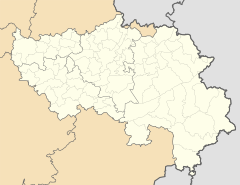Membach
| Membach | ||
|---|---|---|
|
|
||
| State : |
|
|
| Region : | Wallonia | |
| Province : | Liege | |
| District : | Verviers | |
| Coordinates : | 50 ° 37 ′ N , 6 ° 0 ′ E | |
| Residents: | 1,200 pop. | |
| Height: | 250 m | |
Membach is a Belgian town in the Walloon region , just under 2 kilometers west of Eupen . The town with around 1200 inhabitants has been part of the municipality of Baelen since the municipal merger in 1977 . The center of Membach is located in a side valley of the Weser - on the Eupener Stadtbach, popularly called de Bach in Membach - and is surrounded by a hilly meadow landscape. The area of the sub-community extends to the southeast but also over large parts of the Hertogenwald to the edge of the High Fens .
history
The place was first mentioned in an official act in 1172 as "Menebach". At that time the inhabitants belonged to the parish of Baelen. The center of the village is the church, built in 1722 and dedicated to John the Baptist. In 1803 Membach was raised to an independent parish by the Liège bishop Jean-Évangéliste Zaepffel, who was deployed under French occupation .
In the first half of the 20th century, Membach had its own train station. This was on the "Oebahn" built in 1896, a railway line that connected the industries in the lower town of Eupen and the Weser valley with Dolhain and the international railway network running there. The manufacturers of the Lower Town of Eupen, led by the Chairman of the Eupen Chamber of Commerce and Industry, Robert Wetzlar , were particularly committed to the construction of this route . The railway also served to transport wood from the Hertogenwald. Passenger transport was switched to buses as early as 1926. Eupen- Goé freight traffic was discontinued in 1959 and traffic on the Goé-Dolhain route in 1963.
In 1852, the “Société anonyme des mines et fonderies de plomb de Membach” began in the area of the district of Perkiets on the initiative of the industrialist Alfred Mosselman with the development of a zinc and lead ore deposit in the Weser valley. The activity had to be stopped after a few years because of excessive costs and incorrect calculation of the thickness of the ore deposit. The only remnants from this time are the machine halls, which have since been converted into residential units, and the former director's villa with administration wing.
One of the Belgian seismic stations was set up in 1977 in a 130 m deep tunnel on a mountain slope behind the Weser, and has since been equipped with new technology several times. Worldwide earthquakes are registered and documented in it. The operator is the Royal Observatory of Belgium .
photos
Web links
- Website of the place with picture gallery
- Liberation of Membach by the Allies on September 11, 1944 (French)
- The Perkiets Bridge in Membach 1914 (French)
Individual evidence
- ↑ Grenz-Echo: Report on the Oebahn ( Memento of the original from March 4, 2016 in the Internet Archive ) Info: The archive link was inserted automatically and has not yet been checked. Please check the original and archive link according to the instructions and then remove this notice.
- ↑ Reiner Bimmermann: The Eupener Kleinbahnnetz (1906–1956) pp. 131–134, in the yearbook Geschichtliches Eupen, Volume XXVIII. 1994
- ↑ Christian Rutsch: Eupen and the surrounding area. Julius Mayer, Eupen 1879
- ^ RTBF: Record du monde scientifique à Membach
- ^ BRF: Seismological station in Membach has registered earthquakes in Mexico





